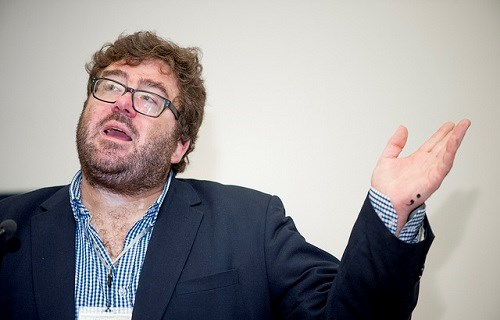“Veil of ignorance” obscures effective solutions to physical inactivity

Richard Bailey, PhD, Senior researcher, ICSSPE. Photo: Thomas Søndergaard
27.10.2015
By Rachel PayneWith the juicy elite sport topic of match-fixing competing for the limelight in the main auditorium, six presenters representing the education, research, business and non-profit sectors underlined the ‘real life’ threat of physical inactivity to the general population and reasons why physical activity promoters and policy makers are sometimes missing the mark when it comes to increasing participation levels.
“The sports taking place among teenagers, even football, have nothing – or very little – to do with FIFA,” Maja Pilgaard, Head Researcher at the Danish Institute for Sports Studies, pointed out. “A lot of the children who are playing soccer may not even be interested in watching soccer on TV – they’re interested in participating.”
The problem is that 4 in 5 adolescents and 1 in 4 adults are not participating enough, Marvin Radford from the International Sport and Culture Association (ISCA) concluded on a recent ISCA/Centre for Economics and Business Research study. With physical inactivity costing Europe an estimated €80 billion a year in associated health costs, his presentation highlighted the problem ISCA describes as the ‘inactivity time bomb’.
The influence of sedentary environments working against humans’ evolution as active creatures and compromising their “effective functioning” reinforces this problem, said session moderator Richard Bailey, from the International Council of Sport Science and Physical Education (ICSSPE), which invited the speakers to evaluate physical activity as a “cause for concern” in Europe.
Harness empirical evidence
So, too, do established myths that underpin sport policy, from Baron de Coubertin’s Olympic mythology, to the pyramid model of sport, to misconceptions of key target groups. A “veil of ignorance” is obscuring the decision-makers’ vision, Bailey argued, so it is time to look through it and bring some real evidence forward.
“To simply say that sport and physical activity is good for us isn’t always good enough, and sometimes we need more information that grabs some attention that strengthens the position of what we’re proposing,” Radford said.
Martin Holzweg and Rose-Marie Repond from the European Physical Education Association (EUPEA) stressed the importance of the school setting as a place where empirical evidence can be gathered and used to improve school-based physical activity interventions. Too often, Holzweg argued, policies are made without enough evidence being sought or validated.
Holzweg pointed to the recently published UNESCO Quality Physical Education Guidelines as an example of a powerful tool that was “a very good idea to publish for policy makers”, but should be “double-checked to make sure it is based on empirical evidence”.
Bailey reinforced the call to “base our judgement on the available evidence and the values associated with mass participation, sport for all and positive physical activity experiences” when developing physical activity policy in his closing presentation.
Aim at the right targets
The speakers agreed that another factor working against those trying to combat the inactivity crisis is that efforts and resources to increase physical activity are being allocated to places where people are already actively participating (such as clubs and physical education) and are therefore narrowly missing target groups that could make a difference.
In the school setting, Repond said that, aside from traditional physical education, “it is important to use the full spectrum of physical activity opportunities we have in schools”.
This includes encouraging exercise in extra-curricular time, such as active breaks and cycling or walking to and from school. This, she believed, would lead to active habits that would continue after their time at school is over and help them meet recommended physical activity levels in their daily lives as adults.
In the case of girls and young women, Maja Pilgaard said this “hard-to-reach” target group is missing out on public support towards the activities in which they like to participate most:
“Is it fair for girls and women to pay for their own participation at a commercial fitness centre when most of the public funding is going to sport clubs?”
The workplace is another obvious setting to turn the inactivity statistics around, but Michael Filtenborg from the Danish Federation for Company Sport pointed out that companies focused too often on pushing the most resistant inactive people to get moving, likening physical activity promotion in the workplace to “a popcorn bag”:
“Some immediately pop, some eventually pop and some never pop.”
Those who eventually pop are your target group, he said, and those who never pop are a waste of your energy.
Stop fiddling with trivialities or sink with the ship
Richard Bailey concluded the session by outlining 10 steps to reversing the physical inactivity epidemic, including helping children “develop a portfolio of movement skills” at the earliest possible age. He advised against “fiddling” with policies that do not focus on creating a culture of movement among children from the outset.
“If physical inactivity is the problem that people like myself and others say it is, what we’re doing in policy terms is actually like shifting deck chairs around on the Titanic [for aesthetic purposes, only for the ship to sink] – which is fiddling with trivialities,” he said.
“If you look at the evidence, the simple truth is that we have a window of opportunity to intervene in the promotion of physical activity, and that is for the first 10 years of [a person’s] life… Physical activity in childhood without movement skill acquisition is pointless – actually it’s worse than that because boredom plus pointless physical activity means that they’ve gone.”
Editor's note: This is a slightly edited version of an article that is also posted on ISCA-web.org





